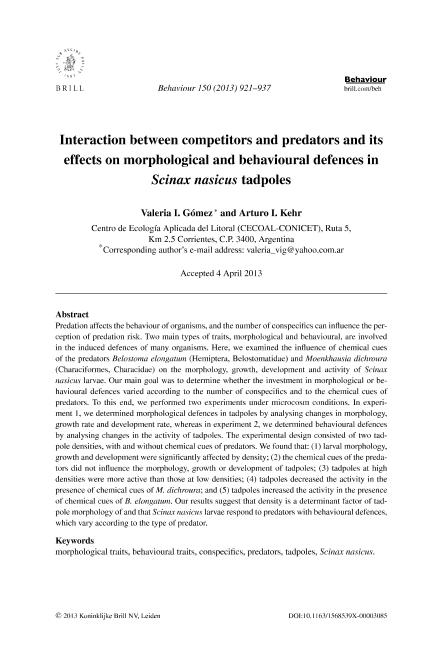Mostrar el registro sencillo del ítem
dc.contributor.author
Gómez, Valeria Isabel

dc.contributor.author
Kehr, Arturo Ignacio

dc.date.available
2015-10-07T18:11:15Z
dc.date.issued
2013-06
dc.identifier.citation
Gómez, Valeria Isabel; Kehr, Arturo Ignacio; Interaction between competitors and predators and its effects on morphological and behavioural defences in Scinax nasicus tadpoles; Brill Academic Publishers; Behaviour; 150; 8; 6-2013; 921-937
dc.identifier.issn
0005-7959
dc.identifier.uri
http://hdl.handle.net/11336/2386
dc.description.abstract
Predation affect the behaviour of organisms, and the number of conspecifics can influence the perception of predation risk. Two main types of traits, morphological and behavioural, are involved in the induced defences of many organisms. Here, we examined the influence of chemical cues of the predators Belostoma elongatum (Hemiptera, Belostomatidae) and Moenkhausia dichroura (Characiformes, Characidae) on the morphology, growth, development and activity of Scinax nasicus larvae. Our main goal was to determine whether the investment in morphological or behavioural defences varied according to the number of conspecifics and to the chemical cues of predators. To this end, we performed two experiments under microcosm conditions. In experiment 1, we determined morphological defences in tadpoles by analyzing changes in morphology, growth rate and development rate, whereas in experiment 2, we determined behavioural defences by analyzing changes in the activity of tadpoles. The experimental design consisted of two tadpole densities, with and without chemical cues of predators. We found that: 1) larval morphology, growth and development were significantly affected by density; 2) the chemical cues of the predators did not influence the morphology, growth or development of tadpoles; 3) tadpoles at high densities were more active than those at low densities; 4) tadpoles decreased the activity in the presence of chemical cues of M. dichroura; and 5) tadpoles increased the activity in the presence of chemical cues of B. elongatum. Our results suggest that density is a determinant factor of tadpole morphology of and that Scinax nasicus larvae respond to predators with behavioural defences, which vary according to the type of predator.
dc.format
application/pdf
dc.language.iso
eng
dc.publisher
Brill Academic Publishers

dc.rights
info:eu-repo/semantics/openAccess
dc.rights.uri
https://creativecommons.org/licenses/by-nc-sa/2.5/ar/
dc.subject
BEHAVIOURAL TRAITS
dc.subject
CONSPECIFICS
dc.subject
MORPHOLOGICAL TRAITS
dc.subject
PREDATORS
dc.subject
SCINAX NASICUS
dc.subject
TADPOLES
dc.subject.classification
Ecología

dc.subject.classification
Ciencias Biológicas

dc.subject.classification
CIENCIAS NATURALES Y EXACTAS

dc.title
Interaction between competitors and predators and its effects on morphological and behavioural defences in Scinax nasicus tadpoles
dc.type
info:eu-repo/semantics/article
dc.type
info:ar-repo/semantics/artículo
dc.type
info:eu-repo/semantics/publishedVersion
dc.date.updated
2016-03-30 10:35:44.97925-03
dc.identifier.eissn
1568-539X
dc.journal.volume
150
dc.journal.number
8
dc.journal.pagination
921-937
dc.journal.pais
Países Bajos

dc.journal.ciudad
Leiden
dc.description.fil
Fil: Gómez, Valeria Isabel. Consejo Nacional de Investigaciones Científicas y Técnicas. Centro Científico Tecnológico Nordeste. Centro de Ecologia Aplicada del Litoral (i); Argentina
dc.description.fil
Fil: Kehr, Arturo Ignacio. Consejo Nacional de Investigaciones Científicas y Técnicas. Centro Científico Tecnológico Nordeste. Centro de Ecologia Aplicada del Litoral (i); Argentina
dc.journal.title
Behaviour

dc.relation.alternativeid
info:eu-repo/semantics/altIdentifier/doi/http://dx.doi.org/10.1163/1568539X-00003085
dc.relation.alternativeid
info:eu-repo/semantics/altIdentifier/url/http://booksandjournals.brillonline.com/content/journals/10.1163/1568539x-00003085
Archivos asociados
